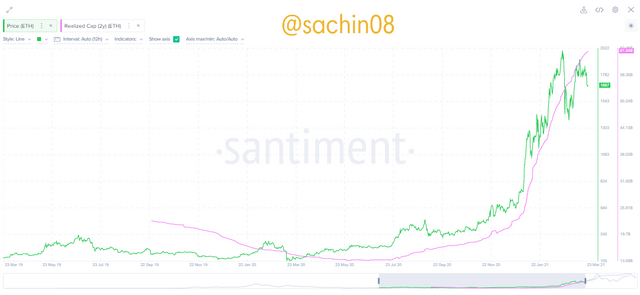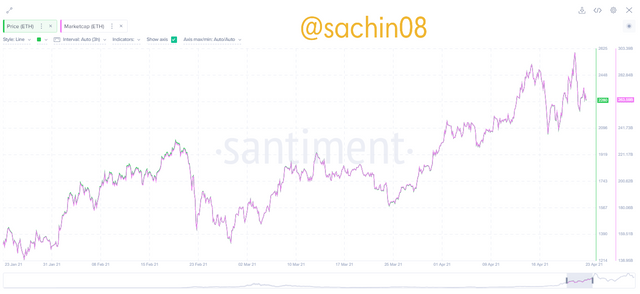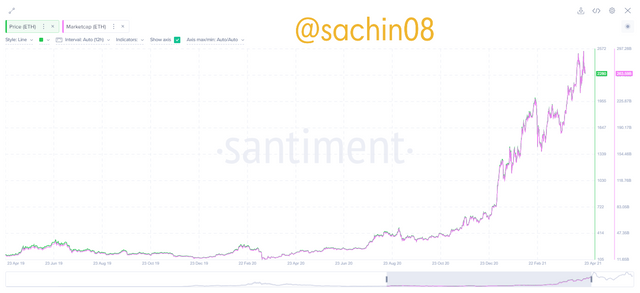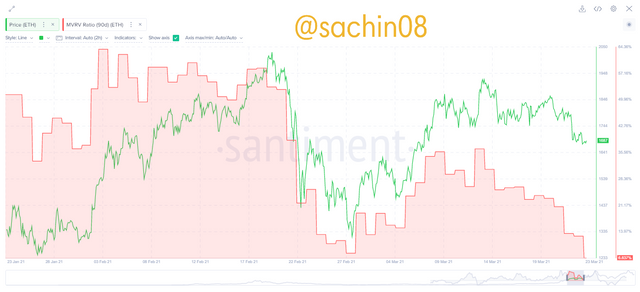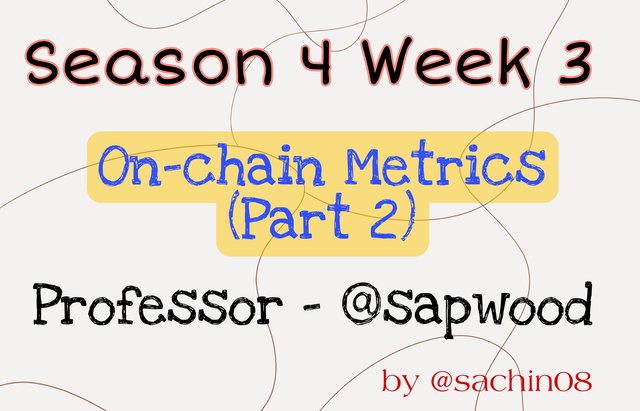
1. What is the difference between Realized Cap & Market Cap, How do you calculate Realized Cap in UTXO accounting structures? Explain with examples?
● REALIZED CAPITALIZATION:
Basically, the Realized Cap (or Capitalization) is a type of on-chain metrics which accounts for the actual valuation of an asset at an interval which is given, through basing its accounting structure on the actual price at which the gjven asset was purchased or last moved.
This calculation of metrics incorporates both spent and unspent UTXO balances so that the realized value of the entire network can be ascertained.The realized cap number is usually below the market cap, which shows that the overall value of the network is positive, due to the unspent UTXO assets within the network.
At the time, when the realized cap number is above the estimated market value (market cap), there is a negative network value, because UTXO balances are spent, so that the new UTXO balance can take the current price of the market. The Realized cap can be get by valuing each UTXO with the last traded price of Asset.
● MARKET CAPITALIZATION:
The market Capitalization is a type of on-chain metrics which a similar amount to the total amount offered by the current price. Market cap is used by the investors to compare quality of the cryptocurrencies, to take decisions accordingly. Market capitalization is most frequently used to show the value of a cryptocurrency asset particularly, when it is compared to other assets.
The market cap shows the development potential of a cryptocurrency and whether buying a considering risk, and adoption of that particular crypto token is safe. An asset's total network price, is determined by the combined value of all the assets that are in existence, and it is defined by the market capitalization of that particular asset. It is calculated by multiplying the most recent price traded with the total circulating supply.
The market cap is very much important. The reason behind it is that is a measure of network scale and also it is a fundamental indicator of a number of aspects about which the investors care. The market Capitalization is Determined by multiplying the circulating supply and price of assets.
Difference between Realized Cap and Market Cap:
| Realized Cap | Market cap |
|---|---|
| Lesser Volatility | Higher volatility |
| Required complex calculations | Easy calculations are required |
| No affect of number of trades | Affected by number of trades |
| Can never be drastic | Can face a drastic reduction |
| Data is advanced | Data is basic |
Calculation of Realized Cap in UTXO accounting structures
The Realized Capitalization considers dormancy of those coins which are most probably in the custody of some diamond holders or in some wallets for which unfortunate reasons are no longer accessible. Lets take an example to understand how the realized capitalization manage this.
Suppose you have a UTXO coin named as 'A' which has current price of $80. If I have bought 10 coins 4 years ago at a unit price of $1.5 and have not been moved traded ever since, the current realized price of those 5 coins is $1.5 x 10 = $15. However, the current market price will be of 10 x $80 = $800.
The realized price of the UTXO coin remains the last price value at which it was sold, as long as the token remains unsold. If ithe UTXO coin sold at the current market price. However, the UTXO has now moved to a new UTXO and so the current market price becomes the last selling price.
Now, let's assume the total amount of UTXOs that coin A has are 25 UTXOs and 25 units in are circulation. Last time, 5 units were sold at $1.5, 15 units were last sold at $3.2, 2 units were last sold at $35 and 3 units were last sold at $57. Then, the Realized Capitalization came out is:
(5 x 1.5) + (15 x 3.2) + (2 x 35) + ( 3 x 57) = $296.5
Now, the current price of market is supposed to be $80 and thus the market Capitalization is calculated would be,
(25 x 80) = $2000
2. Consider the on-chain metrics-- Realized Cap, Market Cap, MVRV Ratio, etc, from any reliable source(Santiment, Glassnode, etc), and create a fundamental analysis model for any UTXO based crypto, e.g. BTC, LTC [create a model for both short-term(up to 3 months) & long-term(more than a year) & compare] and determine the price trend/predict the market (or correlate the data with the price trend)w.r.t. the on-chain metrics? Examples/Analysis/Screenshot?
Now, in this question I have used the website santiment for the analysis of On-chain Metrics. Lets Understand it for the Realized Cap first.
● REALIZED CAP
When there is an uptrend in the price of the market, the Realized Cap increases. When there is a flat market i.e. when there is a neutral trend, the the realized cap also behaves as flat and in at the time of downtrend or bearish market trend, the Realized Cap also effects and it falls at a slow pace as compared to market price.blets see the analysis of short term and long term charts below:
Short term analysis (3 months):
In the above analysis chart of 3 months, it is shown that the graph of the realized cap is moving almost parallel to the movement price of Ethereum. Till 30 June, the Realized Cap was moving in parallel with the eth price and after 30th Jan to 22nd feb, the Realized Cap has remained almost constant at a flat rate but there was an increment shown in the market price.
Then till 9th march 2021, the price has decreased much but the realized cap has maintained in its upward direction. The price further increased and as same the realized cap also moved upward with a little flat shown in the end.
In the chart, once the prices started going up and unspent UTXO was transacted and sent out, the realized cap has began to increase. When prices began to go down the realised cap maintained its Flattened straightened slope.
Long Term Analysis (More than 1 year):
In the long term chart of more than a year i.e. the 2 year graph which is shown in the screenshot above. It is shown that the graph of realized cap is moving almost parallel with the movement of price of Ethereum. When there is a correction in the market, the Realized Cap is remained almost constant and with the increasing of market price, the Realized Cap has increased.
From 23rd march 2019 to 23 July 2020, there was an almost similar price shown, but after 23rd july, the prices began to rise till 22nd nov, and then there was a large rise shown till 23rd march 2021.
Once the prices started to go up the realised cap then picks up and begins to create a slope. When the realized cap remains flat in downtrends, it shows that the investors stopped spending when prices are down.
3 Months vs Long Term analysis:
In the above chart of both 3 months and 2 year, we can see the difference between both. In short-term analysis, on chain metrics does not show the established trend because the investors increases in the bullish market and so the UTXO changes more frequently.
● MARKET CAP
Short term analysis (About 3 Months):
In the chart of Ethereum shown above, the price of an asset from 23rd Jan to 3rd march, has increased and then decreased but after 2nd March, the price took an uptrend and took an upshoot from 25th March 2021 to 2 or 3 days before 23rd April 2021 at a price of $2625, then it has shown a decline in price till 23rd April and came to a price trend of $2280.
The movement of market cap is in direct proportion and ratio with the action of price and when prices go up or down, the market cap will equally go up or down because it will get multiplied with the circulating supply and an estimated market value is achieved.
Long Term Analysis (More than 1 year):
In the above chart, from 23 April 2019 to 23 December 2020, the price has increased slowly and then till 22nd February 2021, the price took a major uptrend and rised much. Then it took a decline and after that it again rised up till 23 april.
The market cap increases with the increament in daily closing prices and decreases with decreasing of daily closing prices usually against which the circulating supply is multiplied.
● MVRV RATIO
Short term analysis (3 months):
In the above graph of Ethereum, from 23st jan to 3rd feb 2021, there has seen both increament and decrement in the price of market and then from 3rd feb to around 17th feb, the price has took a good uptrend and rised with a upshoot. Then, again a big downtrend has shown in the price trend and it came down till 27th feb.
The price again took an uptrend from 27th till 14th march and then it flattened till 23rd march 2021. The mvrv ratio has moved up from the price of market till 17th feb and then it cam down with the price and reached below the price.
Long term analysis (2 years):
In the above long run shown graph of more than 1 years, I discovered that the price is equally in a range, when the MVRV ratio is in a range. When it records increases this is in consonance with the price recording increases. From 23rd sept to 23rd nov, the price remains Flattened and after 23rd nov, the price has took a major upshoot and stretched upwards with momentum.
Then the price again took a major downturn from 25 may 2021 to 25th july and then it again started to rise drkm 25th july and then has shown some downtrend. The price has clpsely followed the mvrv ratio. In longer-term, the MVRV ratio has produced more pronounced upward and downward extensive stretches which means they could give more reliable signals in this state.
Being at 100%, the MVRV ratio shows that gain is being made on a normal level. Being a percent level above then 100% the gain is multiplied by the number i.e. if the percent is 200% then it becomes 2X.
3. Is the MVRV ratio useful in predict a trend and take a position? How reliable are the upper threshold and lower threshold of the MVRV ratio and what does it signify? Under what condition the Realized cap will produce a steep downtrend? Explain with Examples/Screenshot?
MVRV Ratio in predicting a trend:
Basically, the MVRV ratio is a good indicator in predicting a trend and to take trade positions despite the fact that no indicator is completely perfect to predict price trends due to its dynamism. The MVRV ratio is best used in analyzing long term and preferably in combination with some other indicators.
The MVRV ratio has a scaled percentage which bands from 0 to 200. When the percentage of the market is below 100, there is a negative trade state, bear trend and probably an undervalued asset. We must anticipate the corrections of market which in this case is Bullish. When the trend seen is above 100% bands, then the trend shown by it is a bull trend, a positive trade state and an undervalued asset.
In the corrections of market, we should anticipate at the time it is bullish. There are four important trend indicators which are Higher Highs, higher lows, Lower highs and Lower lows to guide. When there is a trend which seen above 100% bands, then it shows a bullish trend and probably an overvalued asset. A likelihood of correction in markets is there and therefore anticipate a bearish price movement.
Reliability of Upper Threshold of MVRV ratio:
As we already know from the lessons that the MVRV ratio is largely not reliable. There is relatively a decline in the price of market, although there has seen a bullish trend at this level. Hence, as the higher the upper threshold seen in the ratio of MVRV, there captured a little decline in the price. At this end, the coin may be over valued and there can be a significant sell off so that the profit can be captured.
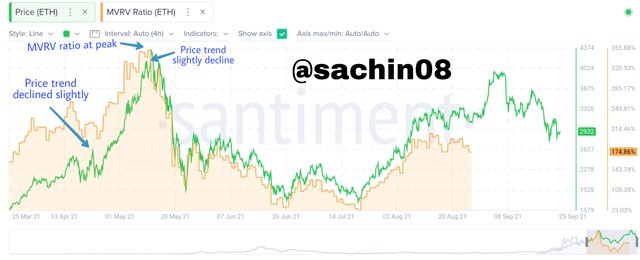
Reliability of Lower Threshold of MVRV ratio:
For the lower threshold, we have seen that it has proven reliable than what we have seen in the upper threshold. The reason is that the lower threshold are always preceeded by an increment in the movement of price. This is the significance of a potential increase in price by the lower threshold. Bullish trends are usually anticipated at this level as the positions of entry are significant.
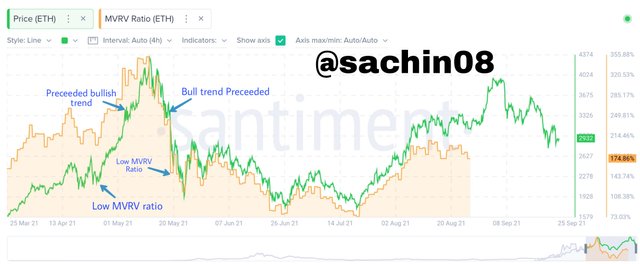
Conditions for producing steep downtrend in Realized cap:
As I have already discussed that the realized cap is calculated by valuing each UTXO of a given coin with the price at which the asset was last traded. So, for a steep downtrend to occur in the realized cap, the holder of that coin must have trade or spent all their UTXOs lower than the last peice at which they were seen traded or spent and it intails they must be spending to incur all the losses.
This practice is not possible practically because at this period, we should be seeing the coin holders significantly Hodl at this time period. This must be spent at that time when the prices are lower than the last price of UTXO. The majority of users usually prefer to wait until the prices are up to take profit rather than spending UTXO lower than their last entry price. Nevertheless, the few users who may decide to sell very much down the line may not be enough to cause a steep downward slope because the major crypto holders may not following same step.
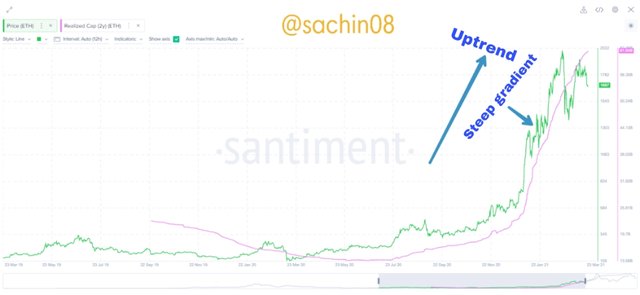
In the above screenshot, we can see that a there is a strong bearish trend in the market. Even then a steep downward slops has not produced like as in the case of steep upward slope which is produced in the upward trend.
CONCLUSION
The realized cap is a type of on-chain metrics which accounts for actual valuation of any asset at a given interval and it is calculated by Valuing each UTXO with the price at which it was last traded. The market Cap is a type of on-chain metrics that is a similar amount to the total amount offered by the price at current time. There are some on-chain metrics can be very crucial to give us a sense of likely trend of price action of any asset.
The lecture of professor @sapwood has proven very informative and helpful for me. I got mich benefit and knowledge about On-chain Metrics and their types. I would like to thank to professor @sapwood for making this insightful lecture.

